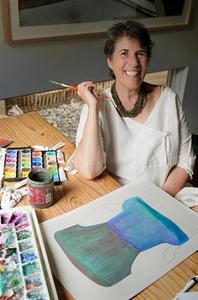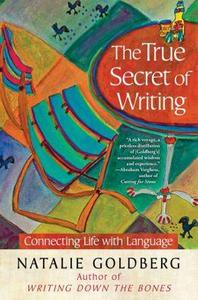
|
|
| photo: Kevin Moul | |
Natalie Goldberg is the author of Writing Down the Bones: Freeing the Writer Within (1986), which started a revolution in the way people practice writing. The book has sold more than 1.5 million copies and has been translated into 14 languages. Goldberg has written eight other books, including fiction and a memoir, and a book on writing memoir, Old Friend from Far Away. She has been teaching seminars on writing as a practice for the last 30 years. In her newest book, The True Secret of Writing: Connecting Life with Language (Atria, $25), she focuses on the technique and outcomes of her silent writing retreats. See our review below.
You've been leading writing groups for 30 some years, including "silent retreats" based on sitting Zen. Do you see The True Secret of Writing as a "how-to" for reproducing your silent workshops?
Partially that. I wanted to record it because it's something wonderful. It's been incredible for every one who's done it. People who've done it never come back to my regular workshops. The silence has been tremendous for people. But also, I'm 65 now. I'm not going to live forever--so here it is, someplace you can find it if you want it. It's a legacy book--all of it rolled together
Explain the combination of spirituality and writing that's the core of your work in so many ways.
It's never been any other way. My great writing teacher was my Zen teacher, Katagiri Roshi. Even though we never discussed writing, I learned about being present and I learned about the elements that you need as a writer through practicing Zen. I got to study my own mind. What are the tools of a writer but pen, paper and the human mind? The better you understand the human mind the better you can use it. Also, I think I understood that life isn't permanent, and at the same time we have an incredible urge to express our life. Not make it permanent, but to say "I was here, I did this, I exist." And really everything I teach is backed by 2,000 [Zen] years of watching the mind. That's true from Writing Down the Bones on. This is my 12th book and I've never veered from that.
I was dumbstruck when I read your advice to let go of the idea of the novel and spend two years on practice as a starting point.
Because it's America and we're all so ambitious, I say two years. I'd love to say 10. You know, when my students hear that, it's such a relief because then they're allowed to just write.
What I teach is a priori writing. A priori means before. Before you decide to be a novelist, or write fiction or nonfiction or memoir or essays or be a journalist, I teach you how to have a strong spine. To trust your mind. To have confidence in your experience--that it's valuable enough to write about. Once you have that and you understand the basics of writing, then you can choose whatever you want, wherever you want to go. My job is to build those spines.
 Many of us have well-thumbed, marked-up copies of your books on our shelves that we go back to all the time. Do you have writing books you go back to?
Many of us have well-thumbed, marked-up copies of your books on our shelves that we go back to all the time. Do you have writing books you go back to?
No, I don't read writing books. I read literature. I read literature because those writers are my writing teachers. I study their minds while I'm reading their books. I just finished two novellas by Jane Smiley, Ordinary Love and Good Will. I read them slowly, and I watched how she unfolds the story--brilliant. In a sense I was studying Jane Smiley's mind.
The truth is that we all have the same principles of mind; we just have different details and inclinations. So you enrich your mind by studying other minds. And then of course, in writing you get to meet your own mind.
Tell us a little about the phrase "shut up and write."
Oh! It's everything. Shut up and eat. Shut up and live your life. Shut up and run. We have such a monkey mind that goes on and on. I'm having trouble writing; I should hire a psychiatrist to discuss it. I need a really nice studio. I need a comfortable café. Finally, stop all this. Just shut up, pick up the pen and get moving. And really, it's what I have said from the very beginning. That's really the only teaching you need.
Silence is the back of all the talk. And so we need to get more in the center. We're leaning too far forward. In a way, the silence for a week [in the workshops] is the antidote to all the talking all the time.
The idea isn't to be silent all the time: you call me and I don't say a word. The idea is to feel comfortable eventually with silence and non-silence and to move in and out of that. You're not afraid of the silence and you're not running from it. In the silence, you get to digest things. And really, you know what silence is? A relief. We don't shut up. I don't know about you, but I go to parties where I meet someone. They'll go on and on. I have not said a word for the entire conversation. They have no idea who I am. What happens is that isolates us. We want to communicate back and forth. Silence will teach you that.
You describe this book as a legacy. But what's next?
I have a painting book that came out in 1997 called Living Color: A Writer Paints Her World.... I just re-sold it to Abrams, which I'm very thrilled about. I'm working on adding chapters and adding paintings. Abrams asked me if I would include some painting exercises. And I didn't really want to because painting's my darling pleasure. I wanted something just for myself. Then I decided it would be fun. And it has been incredibly fun. That's what I'm working on now. And I'm also working on a collection of my essays. I've written a lot of essays. Not about writing; about other things. A bunch of them have been published in Shambala Sun. And I'm becoming an athlete in my later years. I'm hiking like a maniac and doing a lot of yoga. So this is a legacy, but it's not--
It's not the end. It ain't done yet.
--Pamela Toler, blogging at History in the Margins

